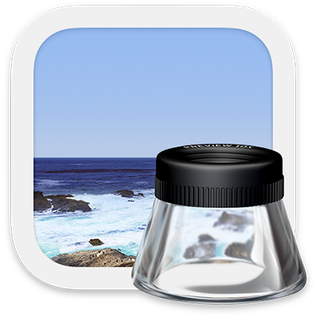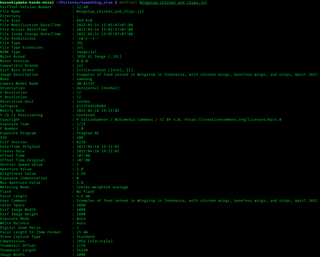
Preview is the built-in image viewer and PDF viewer of the macOS operating system. In addition to viewing and printing digital images and Portable Document Format (PDF) files, it can also edit these media types. It employs the Aqua graphical user interface, the Quartz graphics layer, and the ImageIO and Core Image frameworks.

Hierarchical Data Format (HDF) is a set of file formats designed to store and organize large amounts of data. Originally developed at the U.S. National Center for Supercomputing Applications, it is supported by The HDF Group, a non-profit corporation whose mission is to ensure continued development of HDF5 technologies and the continued accessibility of data stored in HDF.
Digital Negative (DNG) is a patented, open, lossless raw image format developed by Adobe and used for digital photography. Adobe's license allows use without cost on the condition that the licensee prominently displays text saying it is licensed from Adobe in source and documentation, and that the license may be revoked if the licensee brings any patent action against Adobe or its affiliates related to the reading or writing of files that comply with the DNG Specification. It was launched on September 27, 2004. The launch was accompanied by the first version of the DNG specification, plus various products, including a free-of-charge DNG converter utility. All Adobe photo manipulation software released since the launch supports DNG.

digiKam is a free and open-source image organizer and tag editor written in C++ using the KDE Frameworks.
The Extensible Metadata Platform (XMP) is an ISO standard, originally created by Adobe Systems Inc., for the creation, processing and interchange of standardized and custom metadata for digital documents and data sets.
An image file format is a file format for a digital image. There are many formats that can be used, such as JPEG, PNG, and GIF. Most formats up until 2022 were for storing 2D images, not 3D ones. The data stored in an image file format may be compressed or uncompressed. If the data is compressed, it may be done so using lossy compression or lossless compression. For graphic design applications, vector formats are often used. Some image file formats support transparency.
A camera raw image file contains unprocessed or minimally processed data from the image sensor of either a digital camera, a motion picture film scanner, or other image scanner. Raw files are named so because they are not yet processed and therefore are not ready to be printed, viewed or edited with a bitmap graphics editor. Normally, the image is processed by a raw converter in a wide-gamut internal color space where precise adjustments can be made before conversion to a viewable file format such as JPEG or PNG for storage, printing, or further manipulation. There are dozens of raw formats in use by different manufacturers of digital image capture equipment.
Developer's Image Library or DevIL, started by Denton Woods, is a cross-platform image library which aims to provide a common API for different image file formats. It consists of three parts: the main library (IL), the utility library (ILU) and the utility toolkit (ILUT), mirroring the corresponding parts of OpenGL.

A comic book archive or comic book reader file is a type of archive file for the purpose of sequential viewing of images, commonly for comic books. The idea was made popular by the CDisplay sequential image viewer; since then, many viewers for different platforms have been created.
Windows Imaging Component (WIC) is a COM-based imaging codec framework introduced in Windows Vista (and later available in Windows XP Service Pack 3) for working with and processing digital images and image metadata.
In computing, a bitmap is a mapping from some domain to bits. It is also called a bit array or bitmap index.

LightZone is a free, open-source digital photo editor software application. It was originally developed as commercial software by the now-defunct Light Crafts. Its main purpose is to handle the workflow, including non-destructive editing when handling images in various RAW formats. It is comparable to Adobe Lightroom.

FastPictureViewer is a freemium image viewer for Windows XP and later. Its aim is to facilitate quick review, rating and annotation of large quantities of digital images in the early steps of the digital workflow, with an emphasis on simplicity and speed. As an app with a freemium license, a basic version is available cost-free for personal, non-profit or educational uses, while a commercial license is required for the professional version with additional features. The basic version starts as a full version trial.

ExifTool is a free and open-source software program for reading, writing, and manipulating image, audio, video, and PDF metadata. It is platform independent, available as both a Perl library (Image::ExifTool) and command-line application. ExifTool is commonly incorporated into different types of digital workflows and supports many types of metadata including Exif, IPTC, XMP, JFIF, GeoTIFF, ICC Profile, Photoshop IRB, FlashPix, AFCP and ID3, as well as the manufacturer-specific metadata formats of many digital cameras.
KDE Image Plugin Interface is an API that allows creation of application-independent image processing plugins in the KDE project.

WebP is an image file format developed by Google intended as a replacement for JPEG, PNG, and GIF file formats. It supports both lossy and lossless compression, as well as animation and alpha transparency.

Pics.io is a digital asset management app developed by TopTechPhoto. It aims to improve work with images/videos/graphics using Google Drive and Amazon S3 as storage through a centralized library with advanced search options such as keywords and custom metadata fields.
Better Portable Graphics (BPG) is a file format for coding digital images, which was created by programmer Fabrice Bellard in 2014. He has proposed it as a replacement for the JPEG image format as the more compression-efficient alternative in terms of image quality or file size. It is based on the intra-frame encoding of the High Efficiency Video Coding (HEVC) video compression standard. Tests on photographic images in July 2014 found that BPG produced smaller files for a given quality than JPEG, JPEG XR and WebP.
JPEG XL is a royalty-free raster-graphics file format that supports both lossy and lossless compression. It is designed to outperform existing raster formats and thus become their universal replacement.
LÖVE is a free, open-source, cross-platform framework released under the zlib license for developing 2D video games. The framework is written in C++ and uses Lua as its scripting language and is still maintained by its original developers.






